Efficient processing of photos in Photoshop
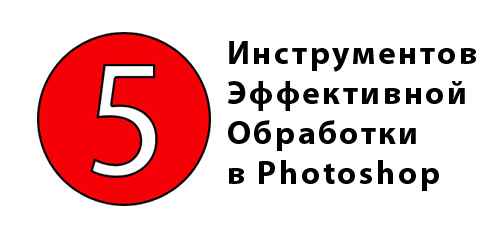
Reading articles about Photoshop, I often wonder how many authors complicate the decision of essentially simple processing tasks. This also affects many "monumental" writers, such as Dan Margulis. But this is forgivable to him - his task is to write about all the subtleties and nuances of the processing process, to consider it from all angles and sides. Although this particular feature of presenting material in his books repels many readers.
In fact, the roots of such ways to “sharpen 40 actions” grow out of a very simple thing - the people who write these lessons never worked with a lot of photos. That is, as a rule, they have a couple of photos and they are ready to kill an evening or two in the course of their processing. But when you have regular orders, and with each photo shoot you need to do a few dozen frames seriously, you start thinking about simpler and more convenient ways of processing.
')
We will talk about them today. I will tell you about five simple but very effective Photoshop tools that I constantly use in my work.
Before processing photos in Photoshop, I always first work with frames in a RAW converter . It is there that I conduct the main color correction and primary processing of photographs. In fact, I create a “skeleton” of processing, and in Photoshop I already work with the details of a photo.
So, we have worked with a photo in the RAW-converter and open it in Photoshop. Photoshop greets us with a huge number of tools for processing for all occasions. But we will talk about the most simple and effective ones.
1. Dodge Tool / Burn Tool

The main function of the Dodge Tool / Burn Tool is to lighten / darken individual parts of the image. In fact, you can “paint” the blackout or vice versa - lighten the picture. It's very simple, try it: sure, you will appreciate this tool. Dodge / Burn Tool has only two, but very important settings.
Range - Select the application
You can use this tool on dark (Shadows), light (Highlights) or neutral (Midtones) photo areas. For example, you need to lighten the dark areas of the chin (when processing the portrait ), and leave the light ones untouched. In this case, we set the Shadows mode in the Dodge Tool, and it will only brighten the dark areas of the places to which we apply it.
Exposure - force of impact
It is very important to set the impact force correctly. Many people, experimenting with Photoshop, try Dodge / Burn 100%. And, darkening the image, get black "holes", and lightening - continuous overexposure. Of course, getting such a result, they no longer return to this tool. But Dodge / Burn is a subtle tool. If you work in shadows or highlights - try the application power in 7-10%, if with neutral areas - 10-20%. For each case, the force of impact is selected separately, but after working a little with this tool, you will begin to feel what kind of power is needed in each particular case.
Using
Dodge / Burn has a lot of ways to use:
- Lighten the iris
- Darken the lines of the shape of the face in a male portrait
- Brighten backlight areas
- Whiten your teeth
Using the Dodge Tool is the easiest and most effective way to whiten teeth in a photo. A little later, I will definitely write a separate lesson about proper teeth whitening with the help of the Dogde Tool.
2. Clone Stamp

In Photoshop, there are several tools for retouching images, and each of them is good in its own way. But "Stamp" - the most versatile tool in use.
Its function is to take a certain part of the image and copy it. Thus, we can, for example, retouch wrinkles - simply “replacing” them with areas of smooth skin. To do this, press Alt and select the area from which the picture will be taken, and then, simply clicking on the desired areas of the image, we will copy it to them.
In the settings of the stamp, it is important to pay attention to two parameters:
Mode
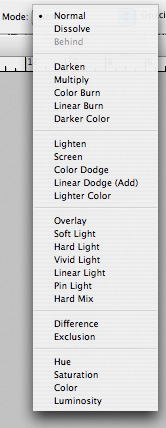
These are the modes in which the stamp will work. For example, in the Darken mode, a stamp will “replace” only lighter zones than the selected area. In fact - you can dim the bright areas of the image, that's why the name of the mode is Darken. And, consequently, in the Lighten mode, the stamp will only work on the darker areas of the image, lightening them.
Clone Stamp has many modes of operation - experiment with them, I'm sure you will get interesting results.
To describe the work of each mode, in my opinion, it does not make sense - in Photoshop for all the tools there are essentially the same principles of operation of the modes, only slightly changing the specifics of a particular tool.
Opacity
Opacity means opacity. Simply put, the less you set the percentage in this setting, the more transparent the “work” of the stamp will be. For example, at 100% the stamp will completely replace the selected area, and at 50% it will be translucent. For the retouching of the face, as a rule, 10–30% is used, otherwise the mark of the stamp will be clearly visible.
Using Clone Stamp
- Retouch
Retouching in all its manifestations is the main purpose of the stamp. First of all, a stamp is used for retouching skin - remove wrinkles, bruises under the eyes, swelling and other beautiful creations of mother nature.
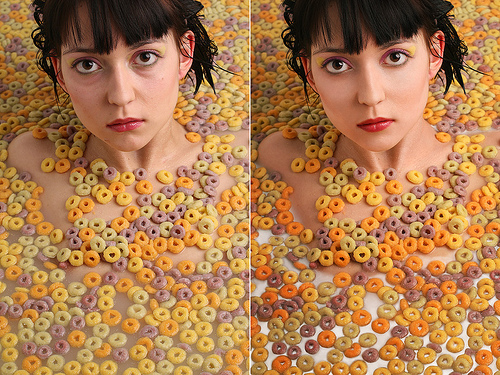
You can also retouch, for example, an unwanted object in the frame. Unless, of course, he takes up half the photo.
It is very convenient to use a stamp to eliminate small peresvetov. For example, your model has a small spot of overexposure on the tip of the nose. We take a stamp, set the Darken mode and in a couple of clicks we darken this spot.
3. History Brush
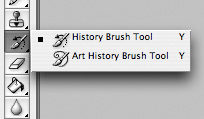
History brush is a time machine for processing photos. You can take any stage of processing and draw a brush out of it in your image.
History Brush is fraught with great opportunities. In detail about the work of this tool, I already wrote in a separate article . In it you will find a detailed lesson on the use of histori brush and learn how to increase the sharpness only on the parts of the image you need.
Of course, sharpening is not the only area of its application. In future articles, I will tell you how to work with the History Brush with the help of the color on the photo.
4. Black & White
The Black & White tool is located in the Image -> Adjustments tab. Or you can simply create an Adjustment layer in the photo.

The main function of the Black & White tool is the “correct” transfer of a color image to b / w. Correct because you can change the black and white display of each of the colors. Thus, you can get a beautiful and "tasty" b / w image.
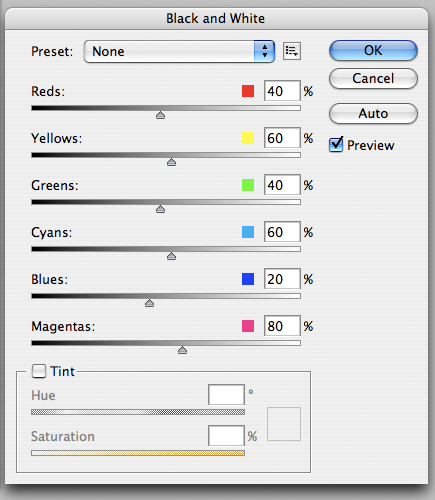
But at this functional B & W is not limited.
With this tool you can get a very interesting and colorful picture. Apply to our B & W image, and then turn on Overlay layer mode.
Now, by manipulating the controls of the B & W and layer transparency, we can get a very interesting picture. For greater clarity, I set a rather high Opacity layer with B & W - 62% and turned the maximums on the Greens, Cyans, Blues and Magentas levers.
As we can see, the picture became immediately richer and more contrast (click on the image to enlarge).
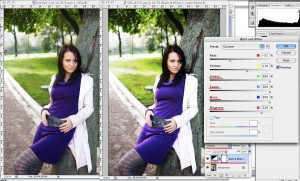
And now let's pay attention to the Tint checkbox. Turning it on, we can tint the image in the color we want.
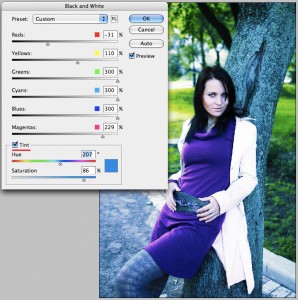
Using
Options for using B & W as when working with color, and when processing B / W - weight.
In one of the following articles, on the example of processing several photos, I will talk about all the main nuances of working with Black & White.
5. Shadow / Highlights
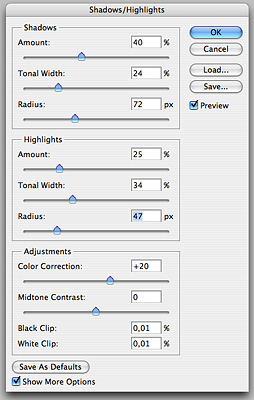
Shadow / Highlights is also located in the Image -> Adjustments tab (in general, by the way, there are many interesting tools, I advise you to experiment with everyone)
This tool is designed to darken overexposed areas and draw light from the shadows. In addition to the most obvious application - to eliminate glows and under-light, S / H works great also for creating a feeling of greater depth of the picture. We can add dark halftones to light areas and light ones to dark areas. Thus, the picture will become more voluminous and deep.
For example, in this photo using S / H, I added the volume of puppy's hair and the picture immediately became more interesting.
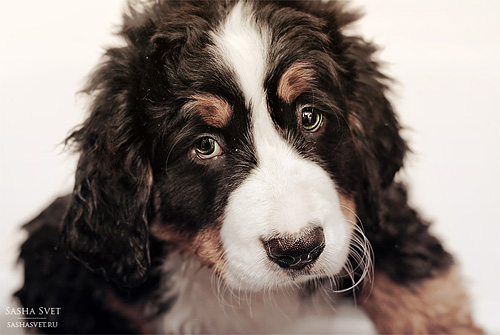
In fact, Shadow / Highlights are an indispensable tool for any serious processing. Virtually any photo can be done better if you apply S / H correctly.
I would like to talk about all the S / H settings and its functionality, but this is really a topic for a separate article. In the future, I will definitely return to the topic Shadow / Highlights, but for now just try to experiment - try different options and look at the result. In my experience, this method is the most effective for mastering new things.
As we can see, all these tools are very easy to use, but at the same time they are amazingly effective. Try experimenting with them and you will feel how many opportunities they give during processing.
I think it’s worth making a series of articles on simple but very effective tools in Photoshop. And in the next article I will talk about tools for serious work with color in the photo.
PS This article was not written by me, but by my good friend and photographer Alexander Light (SashaSvet). If you have any questions about the article, you can write to the author of the article sashasvet
Thank you LeeMiller for an invite! Alexander is already with us sashasvet
Source: https://habr.com/ru/post/102772/
All Articles